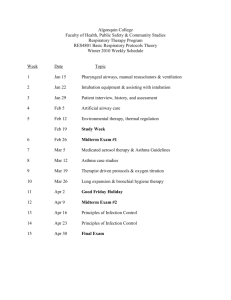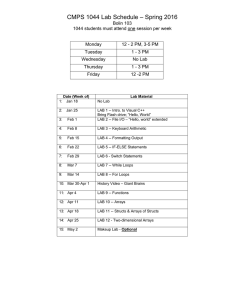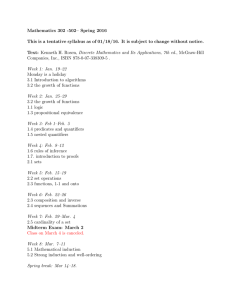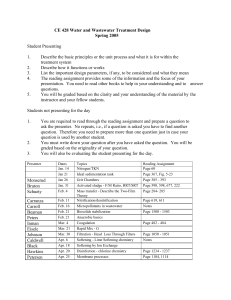REL 107: New Testament update: final exam link week 14
advertisement
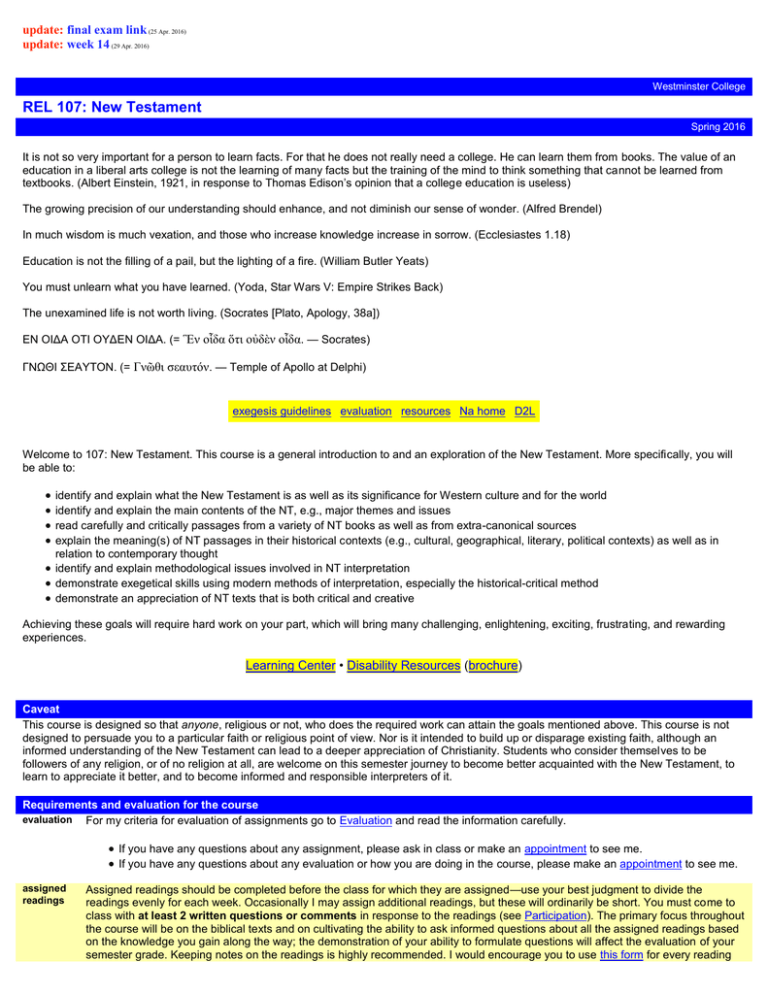
update: final exam link (25 Apr. 2016) update: week 14 (29 Apr. 2016) Westminster College REL 107: New Testament Spring 2016 It is not so very important for a person to learn facts. For that he does not really need a college. He can learn them from books. The value of an education in a liberal arts college is not the learning of many facts but the training of the mind to think something that cannot be learned from textbooks. (Albert Einstein, 1921, in response to Thomas Edison’s opinion that a college education is useless) The growing precision of our understanding should enhance, and not diminish our sense of wonder. (Alfred Brendel) In much wisdom is much vexation, and those who increase knowledge increase in sorrow. (Ecclesiastes 1.18) Education is not the filling of a pail, but the lighting of a fire. (William Butler Yeats) You must unlearn what you have learned. (Yoda, Star Wars V: Empire Strikes Back) The unexamined life is not worth living. (Socrates [Plato, Apology, 38a]) ΕΝ ΟΙΔΑ ΟΤΙ ΟΥΔΕΝ ΟΙΔΑ. (= Ἓν οἶδα ὅτι οὐδὲν οἶδα. — Socrates) ΓΝΩΘΙ ΣΕΑΥΤΟΝ. (= Γνῶθι σεαυτόν. — Temple of Apollo at Delphi) exegesis guidelines evaluation resources Na home D2L Welcome to 107: New Testament. This course is a general introduction to and an exploration of the New Testament. More specifically, you will be able to: identify and explain what the New Testament is as well as its significance for Western culture and for the world identify and explain the main contents of the NT, e.g., major themes and issues read carefully and critically passages from a variety of NT books as well as from extra-canonical sources explain the meaning(s) of NT passages in their historical contexts (e.g., cultural, geographical, literary, political contexts) as well as in relation to contemporary thought identify and explain methodological issues involved in NT interpretation demonstrate exegetical skills using modern methods of interpretation, especially the historical-critical method demonstrate an appreciation of NT texts that is both critical and creative Achieving these goals will require hard work on your part, which will bring many challenging, enlightening, exciting, frustrating, and rewarding experiences. Learning Center • Disability Resources (brochure) Caveat This course is designed so that anyone, religious or not, who does the required work can attain the goals mentioned above. This course is not designed to persuade you to a particular faith or religious point of view. Nor is it intended to build up or disparage existing faith, although an informed understanding of the New Testament can lead to a deeper appreciation of Christianity. Students who consider themselves to be followers of any religion, or of no religion at all, are welcome on this semester journey to become better acquainted with the New Testament, to learn to appreciate it better, and to become informed and responsible interpreters of it. Requirements and evaluation for the course evaluation For my criteria for evaluation of assignments go to Evaluation and read the information carefully. If you have any questions about any assignment, please ask in class or make an appointment to see me. If you have any questions about any evaluation or how you are doing in the course, please make an appointment to see me. assigned readings Assigned readings should be completed before the class for which they are assigned—use your best judgment to divide the readings evenly for each week. Occasionally I may assign additional readings, but these will ordinarily be short. You must come to class with at least 2 written questions or comments in response to the readings (see Participation). The primary focus throughout the course will be on the biblical texts and on cultivating the ability to ask informed questions about all the assigned readings based on the knowledge you gain along the way; the demonstration of your ability to formulate questions will affect the evaluation of your semester grade. Keeping notes on the readings is highly recommended. I would encourage you to use this form for every reading assignment (also on D2L). Not all the assigned readings may be covered in class or on exams, but they are assigned for your edification in achieving the goals of the course. The more you refer to them in class and in your work, the better your mastery will be, as well as your semester grade. map paper You will draw a map of the Roman Empire during the first century and write a paper on one of the places on the map. You must draw (or trace) the map by hand (on a letter-size paper). How colorful or artistic the map is will not affect the grade. o The map must show important boundaries, territories, and cities of the Roman Empire, as well as the most significant places in Palestine, including the main areas of Jesus’ ministry o The map should include at least the following: Alexandria, Antioch, Athens, Jerusalem, Rome. The paper, which is the main part of this assignment, should consist of 500–800 words on one of the places (area or city). o It should Include: basic or notable facts about the place reasons for its significance for the Roman Empire or for understanding the New Testament, or for both o Do not report merely where or how many times in the NT the place is mentioned; avoid mere summaries or paraphrases of biblical narratives. o Use footnotes or endnotes to document your sources following the Chicago Manual of Style—for help: NoodleTools. Learn the automatic footnote (and endnote) function of your word processor. o Follow all the instructions given on my Evaluation page under Written assignments. o The Oxford Bible Atlas and the maps at the end of NOAB (see “Required books” below) are good places to start. o If possible, scan and insert the map at the end of your paper file; if not, submit the map separately. As soon as you submit your paper, make an appointment to review your graded paper with me. You may be given the chance to revise your paper after its evaluation. Should you choose to do so, your revision will be evaluated and the final grade will be the average of the two. exegesis paper option You may choose to write an exegesis paper instead of the final exam (written or oral—see below). You must meet with me as soon as possible before March 15 to discuss your preference. If you decide to write the paper, follow the directions below: You will submit at Turnitin.com an exegesis paper on a portion of 1 Corinthians 15. In choosing a specific part or theme within 1 Corinthians 15, consult critical commentaries and academic journals, i.e., scholarly books and articles with lots of (foot)notes. For help with exegesis, see my Exegesis guidelines page. You may also find the Tips for writing papers helpful. If you wish to work on a different NT passage, make an appointment to discuss your passage of choice. Make an appointment as early as you can in the semester to discuss (1) your paper idea and (2) your preliminary bibliography (bring a hard copy). The narrower and more specific your thesis—i.e., the argument you plan to make in your paper—the better. The paper should consist of 1,000–1,300 words. Include at least a historical-critical understanding of the text(s) and present possible meanings in it (them). If possible (or appropriate) include an analysis of the structure of the text(s). The paper should represent original work (i.e., your own thoughts), not a mere digest of other people’s opinions. Your own reading and re-reading of the relevant texts, as well as review of other materials, are fundamental to the task. I want to know what you discover in your engagement with the biblical text, whether or not you agree with the course books, commentaries, or opinions presented in class, including mine. o Focus on honing your ability to argue for your opinions and conclusions by supporting them with evidence from texts (especially primary texts) and other relevant sources. Your final bibliography (not just “works cited”) must contain at least 8 sources used in your paper, including at least 4 periodical (journal) articles. Electronic sources count only if you provide evidence that they are scholarly sources (usually in print). Use footnotes or endnotes to document your sources following the Chicago Manual of Style—for help: NoodleTools. Learn the automatic footnote (and endnote) function of your word processor. Follow all the instructions given on my Evaluation page under Written assignments. You may be given the chance to revise your paper after its evaluation. If you submit a revision, the final grade will be the average of the grades earned on the original and on the revision. terms Throughout the semester, you will be responsible for learning significant terms covered in our texts or in class. You will be responsible for finding the definitions, e.g., using course texts (index, glossary) and resources listed in “Resources to consider” below and reliable Web sources. The terms may constitute a part of any quiz or exam. quizzes & exams The midterm exam will cover all the materials in the course we will have covered by the time of the exam (e.g., the reading assignments and terms). The final exam will cover the entire sweep of the course. There may be pop quizzes, the results of which will affect the evaluation of your participation. See my Evaluation page under Quizzes and examinations. In lieu of the final exam (or the exegesis paper), you may take an oral exam (30–45 minutes). You must meet with me as soon as possible before March 15 to discuss this option. grades Grades will be determined as fairly as possible. See my Evaluation page under Grades for more information. The final grade for the course will consist of the following: final exam / exegesis paper — 35% Participation is a significant part of this course. midterm exam — 25% map paper — 30% participation (including pop quizzes) — 10% extra credit See my Evaluation page under Participation for more information and instructions. You may earn extra credit any time during the semester. Submit a paper consisting of 700–1,000 words relating something from popular culture (e.g., movie, play, TV show, book, any performance) to a NT text or theme (consult the instructor). The paper should be mostly critique (not mere description or summary). The instructor reserves the right to make the final determination concerning any extra credit. You can earn a maximum of 5% toward the final grade. You may write more than one, if you wish, but you will not receive more than 5% total in extra credit. Required books The New Oxford Annotated Bible with the Apocrypha (NRSV). You may use another Bible, if you wish, but the New Oxford Annotated Bible (NOAB) will be the common text for class assignments and discussions (n.b.: table of contents, introductions, essays, tables, glossary, maps, etc. are all very helpful). In all cases, you are encouraged to use other English translations (e.g., NIV) and Bibles in other languages in addition to the NRSV. The Tanakh (the Jewish Bible) is especially recommended for Old Testament passages. Brown, Raymond E. An Introduction to the New Testament. New Haven: Yale University, 1997. Recommended books (* = highly recommended) * Achtemeier, Paul. Inspiration and Authority: Nature and Function of Christian Scripture. Peabody: Hendrickson Publishers, 1999. Brown, Michael J. What They Don’t Tell You: A Survivor’s Guide to Biblical Studies. Louisville: Westminster John Knox Press, 2000. * Brown, Raymond E. Biblical Exegesis and Church Doctrine. Wipf & Stock, 2002. * _______. An Introduction to New Testament Christology. New York: Paulist Press, 1994. * _______. Responses to 101 Questions on the Bible. New York: Paulist Press,1990. * Bultmann, Rudolf. Jesus Christ and Mythology. New York: Simon & Schuster, 1996. Ehrman, Bart D. The New Testament and Other Early Christian Writings. New York: Oxford University Press, 1998. * Goodacre, Mark. The Synoptic Problem: A Way Through the Maze. London: T. & T. Clark, 2001. (n.b. free book online) * Meyer, Paul. The Word in This World. Louisville: Westminster John Knox Press, 2004. Pelikan, Jaroslav. Jesus through the Centuries: His Place in the History of Culture. New Haven: Yale University Press, 1985. * Robinson, James M. A New Quest of the Historical Jesus. London: SCM Press, 1959. Sanders, E. P. and Margaret Davies. Studying the Synoptic Gospels. London: SCM Press, 1989. Segal, Alan F. Rebecca’s Children: Judaism and Christianity in the Roman World. Cambridge: Harvard University Press, 1986. * Strunk, William, Jr., and E. B. White. The Elements of Style. New York: Macmillan Publishing, 1979. (See my Resources page under Miscellaneous for the first edition of Strunk.) White, Gregory. The NET Bible Synopsis of the Four Gospels. Richardson: Biblical Studies Press, 2013. Resources to consider My Resources page, e.g., esp. The NT Gateway Course materials on D2L; online resources, e.g., study guides Bible concordances (also in McGill library) Ferguson, Duncan S. Bible Basics. Louisville: Westminster/John Knox Press, 1995. Turner, Nicholas. The Handbook for Biblical Studies. Philadelphia: Westminster Press, 1982. Keeping in touch During the semester check your e-mail regularly for messages regarding course matters (e.g., changes in the syllabus). Visit and reload (refresh) this page for updates to the syllabus; see also my home page for other information and resources related to the course. Please feel free to make an appointment any time about any course matters. Tips from former students For some practical advice from former students, see the tips page. One last word . . . Regardless of how demanding all of this is, I promise to be as fair as possible. I recognize that you will be very busy this semester pursuing various obligations and passions. I understand. I have my passions too, e.g., my family, music, philosophy, nature, mountain biking, fixing things, food. But I am also very passionate about education, both yours and mine—I mean not just the business of acquiring knowledge but more importantly the total development of honorable human beings. I do not require you to share my excitement about all the things we will cover, but I do expect you to do your best to complete the requirements for the course. To help you do that, I will make myself available outside the class time and the office hours. I will be glad to help you when you are struggling with an assignment. Or if you have any questions, concerns, complaints, and even compliments, I will do my best to take the time to listen and offer my response. Keep in mind that I am here to help you learn. So again, welcome to Religion 107: New Testament. Schedule REL 107 MWF 1030–1130 • = required + = in the library (Please do not check them out.) bold = primary text(s) for presentation or class (discussion) > = recommended / suggested Week 1 Jan 20 W Jan 22 Jan 25 PH 110 General orientation: terms, concepts, approaches •Course syllabus (including Evaluation link; review requirements, expectations, and criteria for grading—ask Qs, if you have any) •Westminster College Mission Statement •Fisher: Effective Learning (pp. 3 & 6; also in Inquiry text) •1 Macc (skim slowly) •Brown, R: xxxii-xlv (skim attentively); chs. 1–2 >Brown, M: Prolegomena; ch. 1 >NOAB: introductory notes •Memorize the books of the Protestant canon in order (learn correct spelling). [also: comparison chart; canons; some early NT canons] •Translation comparison •Christmas Quiz •Easter Quiz (n.b.: take this “quiz” before reading the following) •1 Cor 15.3–10 •Mk 15.40–16.8 •Mt 27.55–28.20 •Lk 23.48–24.53 •Jn 19.25–21.25 •Acts 1.1–2.4 •Gos Pet (n.b. Q10 on “Easter Quiz”) •World-view (ppt link) •Optical conditioning •Optical illusion •World-view (context & perspective) •my room (also here) •Number chaos-order •What do you see? •Xmas Quiz •Greek NT: 1st page •Transmission errors •Manuscript •Grades? •notes in class •Remember: bring your Qs & Cs to each class (see Participation). •Copy all relevant Web pages and resources to your hard disk or flash drive, etc. for easy access. Keep the copies updated. Week 2 NT world: Greeks, Romans, and Jews •Jan 27 & 29: no classes (review syllabus and readings) Jan 27 W Jan 29 Feb 1 Week 3 Feb 3 W Feb 5 Feb 8 Week 4 Feb 10 W Feb 12 Feb 15 •Brown, R: chs. 3–5 •1 Macc (skim slowly) •1 Macc 1–2; 4.36–61 (Hanukkah) •Transmission errors >Brown, M: Rule of Thumb 1–10 >The Greeks (interactive site): read about Socrates, Plato, etc. The Synoptic Gospels •Brown, R: ch. 6 •+Brown: Intro to NT Christology, 155–61 (“A Brief History of the Development of the Royal Messianic Hope in Israel”) •+Sanders & Davies: Synoptic Gospels, 51–119 (skim; n.b. diagrams) •feeding 5K folks (all week): •Mk 6.30–44 (cf. 8.1–10; 19–20) •Mt 14.13–21 (cf. 15.32–39; 16.9–10) •Lk 9.10–17 •Jn 6.1–15 •Inf Gos Thom >Brown, M: Rule of Thumb 11–20 >Nicene Creed; also here and here and here >Apostles’ Creed; also here >coloring scheme for the Synopsis >Synopses (very helpful for comparisons) >some synoptic solutions Mark (a trend-setter?): suffering Messiah •Brown, R: ch. 7 •Mk 1.1–16.8 (–16.20): •Mk 1.1–15 (esp. vv. 9–11, 12–13, 14–15) & ||s •Mk 4.1–20 (esp. vv. 11–13), 33–34 & ||s: purpose of parables? •Mk 4.35–41 & ||s: power over nature (cf. Gen 1.1–3) •Mk 6.1–6a & ||s: unable or unwilling to do mighty works? (cf. Mk 3.31–35: Jesus’ family) •Mk 8.1–9.1 (esp. 8.27–33, 9.1) & ||s •Mk 15.33–16.8 (–16.20) & ||s: What really happened? >Brown, M: Rule of Thumb 21–29; ch. 5 Week 5 Feb 17 W Feb 19 Feb 22 Matthew: teacher par excellence •Brown, R: ch. 8 •Matthew (all): •Mt 1.1–17 & ||: the begat list (cf. 1 Chr 1) •Mt 1.18–2.23 & || (?): where did Joseph & Mary live? •Mt 5.1–7.27 & ||s (?): Sermon on the Mount (walk this way; talk this way) •Mt 5.3–12 & ||: Beatitudes •Mt 5.17–20; 7.21–23: Torah (cf. Heb 3.1–6) •Mt 6.5–15 (cf. Lk 11.1–4): Lord’s Prayer •Mt 7.12: Golden Rule •Mt 10.1–11.1 & ||s •Mt 10.34–39: anti-family? •Mt 13.1–52 & ||s •Mt 18.1–35 & ||s •Mt 19.1–11 & ||s •Mt 20.1–16: fair? •Mt 21.1–11 & ||s: how many animals can Jesus ride? •Mt 25.31–46: sheep & goats •Xmas Quiz •Sermon on the Mount •Phraseology: KoG & KoH Week 6 Feb 24 W Feb 26 Feb 29 Week 7 Mar 2 W Mar 4 Mar 5–13 (break) Luke: champion of the outcast •Brown, R: ch. 9 •Luke (all): •Lk 1.46–55: radical song? •Lk 3.23–38 (cf. Mt 1.1–17): significance? •Lk 4.1–13: when will the devil return? (see 22.3) •Lk 4.14–30: why are they outraged? (cf. 1.46–55; 4.14–30) •Lk 6.17–38, esp. 24–26: cf. Mt •Lk 10.25–37: who’s the neighbor? •Lk 10.27 & ||s; Dt 6.4–5; Lev 19.18; Rom 13.9; Gal 5.14; Jas 2.8 •Lk 10.38–42: women disciples? •Lk 11.1–4 (cf. Mt 6.7–13): which Lord’s Prayer should Christians pray? •Lk 15.11–32: lost & found? •Lk 16.1–9: huh? fair? •Lk 22.7–23 & ||s: Last Supper (when was it? which was first: bread or wine?) •Cotton Patch: Lk 10.25–37 •Cotton Patch: Lk 15 Acts: the early church, from Jerusalem to Rome •Brown, R: ch. 10 •Acts (all): •Acts 2; 8.26–40; 10–11; 15.1–35: the spirit moves in mysterious & blasphemous ways •Acts 9.1–22; 22.4–16; 26.9–18: reports of Paul’s conversion •Acts 17.16–34: apostle among philosophers in Athens •Acts 28.30–31: continuing activity of the Holy Spirit) >Ancient romance (e.g., Paul’s so-called conversion, shipwrecks & near-death experiences) Mar 14 •Course syllabus (including Evaluation link; review requirements, expectations & criteria for grading—ask Qs, if any) Week 8 Mar 16 W Mar 18 Mar 21 •Mar 21: midterm exam John: love divine •Brown, R: ch. 11–14 •logos (“the Word”) in English: note all the English definitions; also here (tip: look for the breaks or spaces) •Phraseology: KoG & KoH •John (all): •Jn 1.1–18: Logos Christology •Jn 3.1–21; 4.1–42; 6; 10; 20 •Jn 6.22–71: eat what? •Jn 12.27–36: cf. Mk 14.32–42 & ||s): agony? •Jn 13.1–20: eat or feet? •Jn 13.31–35: how would others know? •Jn 18.2–11; cf. ||s: the arrest •Jn 20.19–29 (esp. vv. 22, 28); cf. Lk 24.36–43 •1–3 Jn (cf. language of the Gospel According to John) Gospels in retrospect •Bring notes on the exciting, interesting, puzzling, or even upsetting thing you discovered in your study of the Gospels. Week 9 Paul: second founder of Christianity? •Brown, R: ch. 15–18 Mar 23 W Mar 24–28 (break) Mar 29 T Mar 30 Week 10 Apr 1 F Apr 4 Apr 6 Week 11 Apr 8 F Apr 11 Apr 13 •2 Pet 3.15–16: what does this say about Paul? •Gal 1.13–17 (cf. Acts 9.1–22; 22.4–16; 26.9–18): Paul’s call •Isa 49.1–6 •Jer 1.1–10 •1 Thess •1 Thess 4.13–5.11 (cf. 1 Cor 15.51–53): Paul’s (early) eschatology (cf. Phil 3.10–11) •Wrede on Paul •The End Is Always Near (skim) Faith (pistis) & freedom: Galatian problems with freedom •Brown, R: ch. 19–22 •Gal (all) •Gal 2.11–14 (cf. Acts 10–11): Gentiles & Jews in the church •Gal 3 (cf. Rom 4; 7.7–13): what about the Torah? •Gal 3.23–29; cf. 1 Cor 12.12–13 (cf. Col 3.1–11): freedom in Christ •Phil: joy & the Parousia •Phil 2.6–11 •3.2–11 (cf. 1 Thess 4.13–5.11; 1 Cor 15.51–53) •Phlm Unity & freedom in Christ: Corinthian problems with freedom •1 Cor (all) •1 Cor 6.1–20; 10.14–33; 15.51 •1 Cor 12: unity •1 Cor 13: apostle of love (cf. Rom 13.8–10; John 13.34–35; Gal 5.14; Mk 12.28–34; Mt 22.34–40; Lk 10.27; Jas 2.8; Lev 19.18) Apr 7: movie night with the Nas 7:47 PM-ish Feel free to bring DVDs of movies you think your classmates should see. For directions click here. Paul & Paul revisited (revised?) •Brown, R: ch. 23–27 •2 Cor (all) •2 Cor 5.16–21: new creation •Rom (all) •Rom 1.1–6: Paul’s Christology •Rom 9–11: what about Israel? •Rom 13.8–10 (cf. 1 Cor 13; John 13.34–35; Gal 5.14; Mk 12.28–34; Mt 22.34–40; Lk 10.27; Jas 2.8; Lev 19.18): apostle of love •2 Thess •Col Week 12 The church in conflict: false (?) teachers & alternatives to Paul Apr 15 F Apr 18 Apr 22 •Course syllabus (including Evaluation link; review requirements, expectations & criteria for grading—ask Qs, if any) •Brown, R: ch. 28–31 •Eph •Titus •1–2 Tim The early church organizes: on the way to “orthodoxy”? orthodoxy, heterodoxy, heresy •Who’s in charge?: the masculinization of the church & gospel of freedom •1 Cor 11.3–16 •Eph 5.21–6.9 •Col 3.18–4.1 •1 Tim 2.8–15 •1 Pet 2.18–3.7 (cf. Rom 10.11–13; Gal 3.27–29; 1 Cor 12.12–13; Col 3.9–11) Week 13 Other NT Writings: faith under fire •Brown, R: chs. 32–36 (skim attentively) •Heb (all) •Heb 2.1–4; 3.1–6 (cf. Mt); 5.7 •Heb 2.14–18; 4.14–16: Christology •1 Pet (all) •1 Pet 2.11–4.11 (esp. 2.13–17, 18–25): faith & societal issues •Jas (all) •Jas 2.14–26: not quite Paul (cf. Mt) •Jude & 2 Pet (all of both, in this order) •2 Pet 3.1–18: the delay of the Parousia >Gabler: “On the Proper Distinction between Biblical and Dogmatic Theology and the Specific Objectives of Each“ in the Scottish Journal of Theology 33 (1980): 133–158 •bring your Qs & Cs (esp. on the distinction between biblical theology & dogmatic theology) •bring some synoptic examples that illustrate the issues discussed by Gabler (esp. on the distinction between biblical theology & dogmatic theology) Apr 25 M Apr 27 Apr 29 Week 14 •May 2 & 4: no classes (review syllabus and readings, prepare for the final exam) <<< updated May 2 M May 4 May 6 Revelation: the church under persecution (apocalyptic & eschatology) The historical Jesus? The question: So what? (faith, history, text) •Brown, R: ch. 37; Appendixes 1–2; pp. 105–7 (“Portraits of Jesus”) •Rev (all) •Rev 1.1–3 •Rev 5.6; 12.3–9; 13.11–18: portrait of good & evil •Rom 13.1–7, 1 Tim 2.1 & 1 Pet 2.13–17: faith & the empire •Revelation collage <<< new •The End Is Always Near (skim) •Review beginnings of the Gospels •Mt 10.2–4 & ||s: who were the disciples? (n.b. the order)? >Nicene Creed; also here and here and here >Apostles’ Creed; also here >Gos Thom >Sec Gos Mk >Gos Pet >Inf Gos Thom >Prot Jas >James Charlesworth: “The Historical Jesus and Exegetical Theology“ in Princeton Seminary Bulletin 22 (2001): 45–63 >C. S. Lewis: historical Jesus >Paul Meyer: “Faith and History“ in Princeton Seminary Bulletin 10 (1989): 75–83 • bring your Qs & Cs (esp. on synthetic judgment, analytic judgment, and language game) • bring some examples that illustrate the issues Meyer discusses (esp. the 3 interpretative patterns and Meyer’s proposal) May 9 M F i n a l e x a m: 8:00–10:30 (regular classroom) test link exegesis guidelines evaluation resources Na home D2L Without education we are in a horrible and deadly danger of taking educated people seriously. (G. K. Chesterton) Health is merely the slowest possible rate at which one can die. (Anonymous)


